Achieving high coverage of larval-stage mosquito surveillance: challenges for a community-based mosquito control programme in urban Dar es Salaam, Tanzania
- PMID: 20042071
- PMCID: PMC2806382
- DOI: 10.1186/1475-2875-8-311
Achieving high coverage of larval-stage mosquito surveillance: challenges for a community-based mosquito control programme in urban Dar es Salaam, Tanzania
Abstract
Background: Preventing malaria by controlling mosquitoes in their larval stages requires regular sensitive monitoring of vector populations and intervention coverage. The study assessed the effectiveness of operational, community-based larval habitat surveillance systems within the Urban Malaria Control Programme (UMCP) in urban Dar es Salaam, Tanzania.
Methods: Cross-sectional surveys were carried out to assess the ability of community-owned resource persons (CORPs) to detect mosquito breeding sites and larvae in areas with and without larviciding. Potential environmental and programmatic determinants of habitat detection coverage and detection sensitivity of mosquito larvae were recorded during guided walks with 64 different CORPs to assess the accuracy of data each had collected the previous day.
Results: CORPs reported the presence of 66.2% of all aquatic habitats (1,963/2,965), but only detected Anopheles larvae in 12.6% (29/230) of habitats that contained them. Detection sensitivity was particularly low for late-stage Anopheles (2.7%, 3/111), the most direct programmatic indicator of malaria vector productivity. Whether a CORP found a wet habitat or not was associated with his/her unfamiliarity with the area (Odds Ratio (OR) [95% confidence interval (CI)] = 0.16 [0.130, 0.203], P < 0.001), the habitat type (P < 0.001) or a fence around the compound (OR [95%CI] = 0.50 [0.386, 0.646], P < 0.001). The majority of mosquito larvae (Anophelines 57.8% (133/230) and Culicines 55.9% (461/825) were not reported because their habitats were not found. The only factor affecting detection of Anopheline larvae in habitats that were reported by CORPs was larviciding, which reduced sensitivity (OR [95%CI] = 0.37 [0.142, 0.965], P = 0.042).
Conclusions: Accessibility of habitats in urban settings presents a major challenge because the majority of compounds are fenced for security reasons. Furthermore, CORPs under-reported larvae especially where larvicides were applied. This UMCP system for larval surveillance in cities must be urgently revised to improve access to enclosed compounds and the sensitivity with which habitats are searched for larvae.
Figures


Similar articles
-
Community-owned resource persons for malaria vector control: enabling factors and challenges in an operational programme in Dar es Salaam, United Republic of Tanzania.Hum Resour Health. 2011 Sep 28;9:21. doi: 10.1186/1478-4491-9-21. Hum Resour Health. 2011. PMID: 21955856 Free PMC article.
-
Community-based surveillance of malaria vector larval habitats: a baseline study in urban Dar es Salaam, Tanzania.BMC Public Health. 2006 Jun 15;6:154. doi: 10.1186/1471-2458-6-154. BMC Public Health. 2006. PMID: 16776829 Free PMC article.
-
A tool box for operational mosquito larval control: preliminary results and early lessons from the Urban Malaria Control Programme in Dar es Salaam, Tanzania.Malar J. 2008 Jan 25;7:20. doi: 10.1186/1475-2875-7-20. Malar J. 2008. PMID: 18218148 Free PMC article.
-
Larviciding to prevent malaria transmission.Cochrane Database Syst Rev. 2019 Aug 14;8(8):CD012736. doi: 10.1002/14651858.CD012736.pub2. Cochrane Database Syst Rev. 2019. PMID: 31425624 Free PMC article.
-
Contributions of Anopheles larval control to malaria suppression in tropical Africa: review of achievements and potential.Med Vet Entomol. 2007 Mar;21(1):2-21. doi: 10.1111/j.1365-2915.2007.00674.x. Med Vet Entomol. 2007. PMID: 17373942 Review.
Cited by
-
Walking or Waiting? Topologies of the Breeding Ground in Malaria Control.Sci Cult (Lond). 2013 Mar;22(1):86-107. doi: 10.1080/09505431.2013.776368. Sci Cult (Lond). 2013. PMID: 25937707 Free PMC article.
-
Impact of community-based larviciding on the prevalence of malaria infection in Dar es Salaam, Tanzania.PLoS One. 2013 Aug 14;8(8):e71638. doi: 10.1371/journal.pone.0071638. eCollection 2013. PLoS One. 2013. PMID: 23977099 Free PMC article.
-
Community-owned resource persons for malaria vector control: enabling factors and challenges in an operational programme in Dar es Salaam, United Republic of Tanzania.Hum Resour Health. 2011 Sep 28;9:21. doi: 10.1186/1478-4491-9-21. Hum Resour Health. 2011. PMID: 21955856 Free PMC article.
-
Community end user perceptions of hessian fabric transfluthrin vapour emanators for protecting against mosquitoes under conditions of routine use in Port-au-Prince, Haiti.PLoS One. 2024 Jul 10;19(7):e0300368. doi: 10.1371/journal.pone.0300368. eCollection 2024. PLoS One. 2024. PMID: 38985752 Free PMC article.
-
Efficacy Assessment of Autodissemination Using Pyriproxyfen-Treated Ovitraps in the Reduction of Dengue Incidence in Parañaque City, Philippines: A Spatial Analysis.Trop Med Infect Dis. 2023 Jan 16;8(1):66. doi: 10.3390/tropicalmed8010066. Trop Med Infect Dis. 2023. PMID: 36668973 Free PMC article.
References
-
- Kouznetsov RL. Malaria control by application of indoor spraying of residual insecticides in tropical Africa and its impact on community health. Tropical Doctor. 1977;7:81–93. - PubMed
-
- WHO. Malaria vector control and personal protection: WHO Technical Report. . Geneva. 2006. pp. 1–72. - PubMed
-
- WHO. World Malaria Report 2008. Geneva. 2008.
-
- Lengeler C. Insecticide-treated bed nets and curtains for preventing malaria. Cochrane Database Syst Rev. 2004. p. CD000363. - PubMed
Publication types
MeSH terms
Grants and funding
LinkOut - more resources
Full Text Sources
Medical

